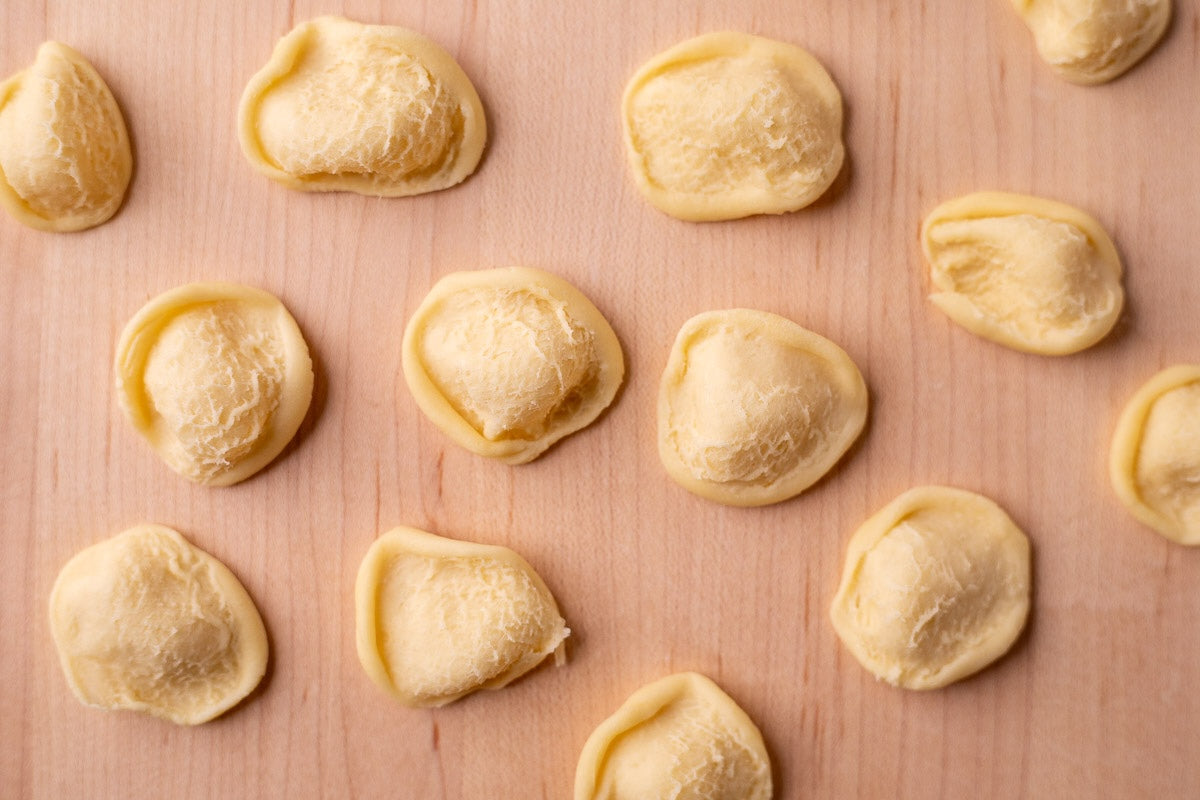Orecchiette, meaning "little ears" in Italian, are one of the most beloved shapes from Southern Italy. Their unique curved, wrinkled form makes them perfect for catching chunky sauces and delivering flavor in every bite. In this tutorial, you’ll learn how to make orecchiette from scratch with nothing more than your hands, a knife, and a little patience.
The Origins of Orecchiette
Orecchiette hail from Puglia, a sun-soaked region in southern Italy known for its golden wheat fields, rustic cucina povera, and deep culinary traditions. These “little ears” have been shaped by hand for centuries—one by one—on wooden boards, usually by the skilled hands of nonnas perched outside their homes.
Nowhere is this tradition more alive than on Strada Arco Basso, a narrow lane tucked into the old town of Bari. Here, the soft scrape of knives against wood fills the air as local women shape orecchiette in a practiced rhythm, chatting with passersby as they work. Their method—known as the “Bari Method”—is a marvel of muscle memory: a single swift motion of the knife both cuts and curls the dough without ever needing to flip it with a thumb. It’s mesmerizing to watch and humbling to attempt.
Traditionally, these ear-shaped beauties are paired with bold, simple ingredients like bitter rapini, anchovies, garlic, and chili pepper flakes. But you’ll also find them dressed in rich ragù alla pugliese or tossed with sweet tomatoes and peppery arugula.
Tools You’ll Need
-
A wooden cutting board or pasta board
-
A butter knife or dull table knife
-
Optional: a large pasta knife, chef’s knife, or bench scraper
Dough Recommendations
Orecchiette are traditionally made with a simple semolina and water dough—no eggs required. It’s sturdy, chewy, and perfect for the robust sauces of the south.
Ingredients:
-
300 grams semolina rimacinata flour
-
150 grams warm water
-
Pinch of salt
Mix and knead the dough following our dough guide. Cover with a bowl or plastic wrap, then let the dough rest for 10-15 minutes after kneading. You need less rest time for orecchiette, as a less hydrated dough is optimal for the tough stretching and curving.
How to Shape Orecchiette: Step-by-Step Tutorial
-
Cut off a quarter piece of the dough and roll the dough into long ropes about a ½-inch thick.
-
Cut the ropes into small ½ inch nuggets.
-
Using the serrated side of a butter knife, drag the dough piece toward you on a wooden board until it curls, pressing down initially to form a lip. It may take a few attempts to get the right pressure. The dough should curl or ripple so that when you flip it over it’s stretched and wrinkled and there is a lip around the edges.
-
Flip the dough inside out over your thumb to form the characteristic “ear” shape.
-
Repeat the process until all your dough has been used up.

Tips:
-
Don’t worry if they’re not uniform—imperfections add charm and once they’re cooked, nobody will be the wiser.
-
If your dough is sliding on the board when you go to roll it out, wet your hands with a little bit of water before rolling the rope. This will create more traction on your board.
-
If your dough sticks to the board when shaping, try dusting with a little semolina or letting your dough “nuggets” dry out for a few minutes before rolling.
Sauce Pairings and Serving Suggestions
-
Traditional: Orecchiette con cime di rapa (broccoli rabe, anchovy, garlic, and chili flakes)
-
Summer twist: Arugula sauce, dried cherry tomatoes, and burrata
Tips, Troubleshooting, and FAQ
-
Can I freeze orecchiette? Yes—freeze on a tray, then transfer to a bag. Cook directly from frozen. Frozen orecchiette will take 3-5 minutes longer to cook than fresh.
-
Why is my dough cracking? Try increasing the water or kneading longer to develop elasticity.
-
Can I use all-purpose flour? You can, but the texture will be softer and less toothsome.
Variations to Try
-
Swap in a mix of 75 grams of spelt flour with 225 grams of semolina flour for a nuttier, heartier flavor.
-
Try smaller or larger orecchiette, depending on your preference. Bigger orecchiette will take less time to make overall, but they may require a slightly longer cook time.
Learn More and Keep Cooking
If you loved learning orecchiette, check out these other homemade pasta guides:
- 5 Pasta Shapes You Can Make with a Gnocchi Board
- 7 Essential for Making Homemade Pasta Like a True Italian
Or, join our Pasta Maker’s Pathway or Italian Cookbook Club to cook alongside others each month with recipes, challenges, and community support.

